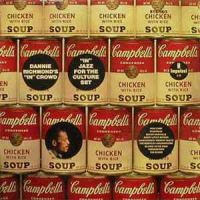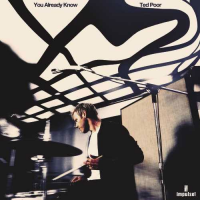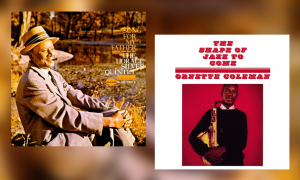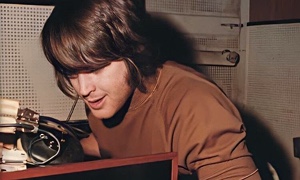Home » Jazz Articles » Building a Jazz Library » Drummers as Bandleaders: An Alternative Top Ten Albums
Drummers as Bandleaders: An Alternative Top Ten Albums

I didn't sit down to write politically inspired material, but I was turning on my TV and seeing tower blocks burning and people being deported and the National Health Service on the brink of collapse. I was responding to what was around me. There's a lot of darkness.
—Moses Boyd
But with every decade that passes, the distinction between "front line" and "rhythm section" becomes more blurred. One consequence is that there will be a corresponding increase in drummers as bandleaders. You can feel the graph rising right now. At the time of writing (spring 2020), three extraordinary albums led by drummers have been released in the last four months alone.
Most jazz libraries will contain a few high-profile drummer-led albums. Likely items include Art Blakey's Moanin' (Blue Note, 1958), or one of the other albums Blakey recorded during Blue Note's pomp; Max Roach's We Insist! (Candid, 1961) or M'Boom (Strata-East, 1973); Tony Williams' Life Time (Blue Note, 1964) or, if Williams' fusion era is preferred, Tony Williams Lifetime's Emergency! (Polydor, 1969); and, more recently, Terri Lyne Carrington's The Mosaic Project (Concord, 2011).
There are plenty of other goodies out there, too. Here are ten of them. A few are well known, most of them less so. Hopefully, you will find one or two new favourites among them.
DRUMMERS AS BANDLEADERS: OFF THE BEATEN PATH
 Chico Hamilton Quintet
Chico Hamilton QuintetChico Hamilton Quintet
Pacific Jazz, 1955
For a brief period in the mid 1960s, Californian chamber jazz was quite a thing. But like so-called West Coast cool, with which it was frequently conflated, it received a hammering from the East Coast jazz establishment, and disappeared almost as quickly as it had arrived. The truth is, much chamber jazz was as anaemic as the critics labelled it. At its best, however, it extended the tonal and compositional possibilities of jazz.
This album by Los Angeles' Chico Hamilton, his debut as leader, sounds as beguiling in 2020 as it must have done sixty-five years ago. The material is strong: six tunes are in-band originals, one is a freely improvised track and three are imaginatively arranged covers (Rodgers & Hart's "My Funny Valentine," Youmans & Caesar's "I Want To Be Happy" and the traditional "Walking Blues"). The lineup is characterful: Buddy Collette on flute, saxophones and clarinet, Jim Hall on electric guitar, Fred Katz on cello and Carson Smith on drums. The album catches Collette and Hall on the first rungs of distinguished careers.
Hamilton had a knack for spotting emerging talent. His 1963 album Man From Two Worlds (Impulse!) features Charles Lloyd and includes the first recording of Lloyd's signature tune "Forest Flower." The sleeve of 1966's The Dealer (Impulse!) announces it is "introducing Larry Coryell."
 Roy Haynes Quartet
Roy Haynes QuartetOut Of The Afternoon
Impulse!, 1962
During his seventy-year recording career, Roy Haynes has produced many delights, and Out Of The Afternoon, made on the cusp of Roland Kirk's transition from underground figure to major star, is among the greatest.
Kirk, who plays tenor saxophone, manzello, stritch and a variety of flutes, bursts out of the gate on the Artie Shaw-composed opener, "Moon Ray," and overall the album is as thrilling as Kirk's contemporaneous own-name Mercury debut, We Free Kings. The key difference is the composing credits. The Mercury set was mostly written by Kirk, the Haynes album is a mixture of standards and Haynes originals: among them Haynes' storming "Long Wharf" and covers of Bart Howard's "Fly Me To The Moon" and Leo Robin and Ralph Rainger's "If I Should Lose You," which is not so much recalibrated as torn apart by Kirk's tumultuous stritch solo.
Such is the impact of Kirk's playing that Out Of The Afternoon is in all but name a Kirk album, buttressed by the superb rhythm section of Haynes, pianist Tommy Flanagan and bassist Henry Grimes.
 Dannie Richmond's "In" Crowd
Dannie Richmond's "In" Crowd"In" Jazz For The Culture Set
Impulse!, 1965
Charles Mingus' drummer from the mid 1950s until Mingus passed in 1979, Dannie Richmond's inimitable style, which marshalled fierce forward motion and delicacy and nuance, is a vital part of over forty albums recorded by the composer and bandleader. Richmond was also, by the by, a sartorialist of the first order, possibly the best dressed man in twentieth century jazz other than Miles Davis.
"In" Jazz For The Culture Set is unlike any of Richmond's work with Mingus. The opening track is Gary McFarland's "High Camp," which could also have served as the title of the album. If the credits did not include Bob Thiele, you might almost imagine Impulse!'s founding producer, Creed Taylor, had made a brief return to the label. The vibe is lounge jazz given substance by a stellar cast of musicians: guitarist Jimmy Raney, harmonica player Toots Thielemans, pianist Jaki Byard, bassist Cecil McBee and percussionists Willie Bobo and Victor Pantoja.
The nine tracks include McFarland's "Pfoofnick," Raney's "Freedom Ride," Byard's "The Berkeley Underground," George Weiss' "John Kennedy Memorial Waltz" and Chuck Berry's "Sweet Little Sixteen." A curiosity which does not extend the boundaries of jazz, but of interest because it was led by a drummer who did.
 Guy Warren Of Ghana
Guy Warren Of GhanaAfro-Jazz
Columbia, 1969
In the 1960s and early 1970s, the drummer and composer Guy Warren was part of a school of progressively inclined, culturally adventurous London-based jazz musicians which also included trumpeter Ian Carr, tenor saxophonist Don Rendell, guitarist Amancio D'Silva and pianist Michael Garrick, who are all heard on Afro-Jazz.
The album is a precursor of the so-called world jazz which emerged in the late 1970s and even of the culturally inclusivist stylings of the 2020 alternative London jazz scene. Warren plays kit drums and an array of hand drums and percussion, supported by second kit drummer Trevor Tomkins from the Carr / Rendell band. All but one tune was written by Warren. The album was so far ahead of its time that it sold only a few hundred copies.
Other Warren albums to look out for are his debut, Africa Speaks America Answers (Decca, 1956), and African Rhythms: The Exciting Soundz Of Guy Warren And His Talking Drum (Decca, 1962). But anything with Warren's name on it is a-grade, even the album of library music titled Native Africa which he made for business-to-business label KPM in 1969.
 Roy Brooks
Roy BrooksThe Free Slave
Muse, 1972
Roy Brooks' The Free Slave is one of the neglected masterpieces of spiritual jazz. Detroit-born Brooks spent the first few years of the 1960s with Horace Silver. He then spent three years with Yusef Lateef, when he shifted his trajectory from hard bop to spiritual jazz: Brooks' debut album, Beat, released by Motown subsidiary Jazz Workshop in 1964, included the Alice Coltrane-composed "Soulsphere."
Brooks suffered from mental health issues throughout his life and was off radar for much of the late 1960s. He returned to view in the early 1970s. The Free Slave was recorded live at Baltimore's Left Bank Jazz Society with tenor saxophonist George Coleman, trumpeter Woody Shaw, pianist Hugh Lawson (also heard on Beat) and bassist Cecil McBee. Three of the four tracks were written by Brooks.
At the time of the disc's release, Brooks could not get arrested. Neither could two albums he went on to make with Roy Brooks & The Artistic Truth—Ethnic Expression and Black Survival (1973 and 1974, Im-Hotep). Both those titles were rereleased at the start of the 2010s. But extraordinarily, Brooks' chef d'ouvre, The Free Slave, has only been reissued once, in 1998. It is worth its weight in gold (and changes hands for almost as much).
 Joe Chambers
Joe ChambersThe Almoravid
Muse, 1974
Joe Chambers is well known to fans of classic-era Blue Note, where he made his name as a sideman and composer on important albums led by players such as Wayne Shorter, Andrew Hill, Bobby Hutcherson, Joe Henderson, Sam Rivers and Freddie Hubbard.
Like Roy Brooks' The Free Slave, Chambers' own-name debut, The Almoravid, is a spiritual-jazz treasure from Joe Field's Muse label, which in the early to mid 1970s ploughed a similar furrow to Strata-East (which gets a Buildng a Jazz Library Top Ten here). The album title refers to the Maghrebi Berber dynasty which governed modern day Morocco and southern Spain in the eleventh century. Chambers leads a percussion-heavy band which also includes Cedar Walton on piano, Cecil McBee and Richard Davis, on acoustic and electric bass respectively, and, on Joe Zawinul's "Early Minor," Harold Vick on tenor saxophone. Four of the remaining five tracks were written by Chambers, one by Andrew Hill.
 Tom Rainey Trio
Tom Rainey TrioPool School
Clean Feed, 2010
Remarkably, Pool School is the first album to be released under his own name by Downtown ninja of subtlety Tom Rainey. His bandmates are guitarist Mary Halvorson and saxophonist Ingrid Laubrock, each in 2010 an emerging new NYC star on her instrument (Laubrock was already a succes d'estime in London, from where she had recently relocated). Both musicians can create intensely visceral music yet are equally at home on more cerebral material, be it pre-composed or improvised, and both are also sonic adventurers who have significantly extended the vocabularies of their instruments. Stir in Rainey's yin / yang rhythmatism and fascination follows.
The album has echoes of Laubrock's collective-improv suite, Sleepthief (Intakt, 2009), on which Rainey made up a trio with pianist Liam Noble. But variety of atmosphere and form is a hallmark of the set. The 12 tracks move adroitly between the composed and the improvised, the inside and the outside, the sun lounger and the deep end.
 Gard Nilssen's Supersonic Orchestra
Gard Nilssen's Supersonic OrchestraIf You Listen Carefully The Music Is Yours
Odin, 2020
Fasten your seat belt, please. Get ready for the full tilt, barely tamed monster that is Gard Nilssen' sixteen-piece Supersonic Orchestra. Audacious and experimentalist, Supersonic flouts convention and, in particular, realigns the relationship between pre-composition and improvisation in orchestral jazz.
If You Listen Carefully The Music Is Yours was recorded live at the Molde International Jazz Festival in 2019, where Nilssen was Artist in Residence. The band's uniquely configured, all-star lineup features three drummers, three double bassists and ten horn players, most of them saxophonists.
Nilssen composed and arranged the album with Andre Roligheten, his colleague in the trio Acoustic Unity. Their approach is sweepingly original, revolutionary even, but there are references to jazz history within it. The disc opens with a feral uproar in which Sun Ra-esque space chords punctuate free-blown ensemble eruptions, devices Ra used to kick off Arkestra performances. Later there are echoes of the eighteen-piece band John Coltrane put together for Africa/Brass (Impulse!, 1961): the otherworldly tumult generated by Coltrane's lineup is mirrored by Supersonic's horn section.
 Ted Poor
Ted PoorYou Already Know
Impulse!, 2020
Ted Poor's fifth album and Impulse! debut is evidence that the once mighty label, which had been allowed to become little more than a platform for underwhelming reissue programs, is on the rebound. The process was kickstarted in 2018 when British reed player Shabaka Hutchings' Sons of Kemet's magnificent Your Queen Is A Reptile was released by the label. Another of Hutchings' bands, The Comet Is Coming, followed Sons Of Kemet to Impulse! in 2019, and a third, Shabaka & the Ancestors , did so in 2020.
The entrancing You Already Know is the perfect polar opposite to Gard Nilssen's If You Listen Carefully The Music Is Yours. While Nilssen drives the epic Supersonic Orchestra, Poor is accompanied only by alto saxophonist Andrew D'Angelo.
You Already Know has its own sorts of grandeur and abandon, however, but it is a simpler and more intimate affair. Each of the nine tracks, which clock in at an average four-and-a-bit minutes apiece, plays with a rhythmic motif and a melodic one in mostly linear fashion. Some tracks are upbeat and urgent, others more reflective. It is the sort of album which gives minimalist jazz a good name.
 Moses Boyd
Moses BoydDark Matter
Exodus, 2020
As half of the ferocious semi-free duo Binker and Moses, in which he is partnered with tenor saxophonist Binker Golding, Moses Boyd is among the most prominent of the musicians who are reinvigorating the London jazz scene. He has also proved himself as a producer, starting in 2017 with singer Zara McFarlane's exquisite jazz / reggae set Arise (Brownswood). Dark Matter moves Boyd's production skills along several more notches.
Boyd and his contemporaries are enriching British jazz with styles such as Afrobeat, reggae, dub and—Boyd's speciality—grime. His first commercial success was the dance single "Rye Lane Shuffle" in 2016, and the breathtakingly inventive and politically savvy Dark Matter builds on its eclectic blueprint. The album features fellow London luminaries including tenor saxophonist Nubya Garcia, pianist Joe Armon-Jones and tuba player Theon Cross, though you would hardly recognise them, such is the extent of Boyd's post-production transformations.
In years to come we may point to Dark Matter as the start of Boyd's emergence as a kind of new Quincy Jones, a hit maker with jazz sensibilities. Meanwhile, the album affirms Boyd as a major-league producer, one who is at home in dance music as he is in the post-John Coltrane jazz tradition, weaving them into a smoking-hot new synthesis.
Photo: Moses Boyd.
Tags
PREVIOUS / NEXT
Support All About Jazz
 All About Jazz has been a pillar of jazz since 1995, championing it as an art form and, more importantly, supporting the musicians who make it. Our enduring commitment has made "AAJ" one of the most culturally important websites of its kind, read by hundreds of thousands of fans, musicians and industry figures every month.
All About Jazz has been a pillar of jazz since 1995, championing it as an art form and, more importantly, supporting the musicians who make it. Our enduring commitment has made "AAJ" one of the most culturally important websites of its kind, read by hundreds of thousands of fans, musicians and industry figures every month.






















